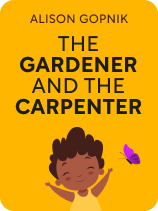

This article is an excerpt from the Shortform book guide to "The Gardener and the Carpenter" by Alison Gopnik. Shortform has the world's best summaries and analyses of books you should be reading.
Like this article? Sign up for a free trial here.
Are you struggling as a parent? Do you often think about what you need to do to turn your child into a well-adjusted, successful adult?
If so, you may be acting as a carpenter parent—a parent who adheres rigidly to the blueprint for raising a “successful child”—instead of a gardener parent—a parent who nurtures the innate interests and talents of their child. In The Gardener and the Carpenter, Alison Gopnik explains how to raise children in a loving and supportive manner.
Read below for a brief overview of The Gardener and the Carpenter.
The Gardener and the Carpenter by Alison Gopnik
In The Gardener and the Carpenter, Alison Gopnik explains that raising and caring for children is an act of love, not work, and that the goal should be to allow children to blossom into their unique selves. People caring for children should support and encourage their natural processes of learning and growth, and societal institutions like schools should adjust their models to do the same. She likens this type of parenting to the work of a gardener nurturing their garden, as opposed to the work of a carpenter building something based on a specific blueprint.
Alison Gopnik is a professor of psychology and affiliate professor of philosophy at the University of California, Berkeley, and the author of such books as The Philosophical Baby, Causal Learning, and The Scientist in the Crib. She also writes the Mind and Matter column for The Wall Street Journal and has written over 100 journal articles.
Parenting: The Gardener Versus the Carpenter
Gopnik explains that our approach to raising children in modern society, particularly in American culture, is flawed because it focuses on a desired outcome when it should instead focus on creating a supportive environment that allows children to discover and explore their uniqueness and individual places in the world. It also treats being a parent like a job when it’s actually a relationship built on love.
Gopnik uses the analogy of a carpenter and a gardener to explain the flaw in the modern parenting model. A carpenter decides in advance what they want to create, and then they shape and mold their material to match their blueprint, avoiding any kind of variation or deviation from that predetermined idea. In contrast, a gardener lays a foundation for growth, providing the resources needed to create and nourish life, but allowing that life to find its own path and grow and change according to its own needs. Our current model pushes parents to be carpenters when they should be gardeners.
This flawed parenting model is reflected in the many parenting books that supposedly provide instructions for how to turn a child into a happy, successful adult, as well as the education system that measures children’s value according to their test scores and then uses those same scores as predictors of their adult outcomes.
How the Carpenter Society Fails Children and Parents
While parents may be the main adult influence in children’s lives, raising children is a societal endeavor and requires a large-scale investment in their care. Gopnik argues that society and its child-caring institutions need to take on the gardener model to best support children and parents.
Though child care has always been a fundamental facet of human existence, it changed drastically during industrialization. Previously, most families in America were farmers, so both parents (and often other family members) were able to work and take care of their children all day. With industrialization, the workplace became separated from the home, leading to the rise of the nuclear family in which the father worked while the mother stayed home with the children. And soon that changed as well, as mothers began entering the workforce and children began living in families where both parents worked—or in single-parent households where the parent simultaneously worked and raised the children.
In the years since this shift occurred, the financial costs of child care have risen dramatically and currently fall largely on parents—as opposed to the ancient model in which communities pooled their resources to take care of children. Gopnik cites a statistic that it costs about $245,000 to raise a child. Because of these costs and the lack of community investment, parents have to choose between working (which means they have to find a way to pay for child care from someone else) and staying home with their children (which means they can’t earn the resources they need to raise their children).
The worst effects of this lack of community investment fall on children themselves. According to Gopnik, more than 20% of children in America grow up in poverty. Poverty also has a cyclical effect, so children who grow up in poverty are more likely to remain poor and raise their own children in poverty.
Gopnik suggests that we need to reinvest in children as a society, offering support to parents through interventions like universal child care, paid parental leave, and direct financial support. Studies show that interventions like these have long-lasting benefits for children and lead to greater health and prosperity in adulthood.
Supporting Instead of Controlling: How Children Learn
A major flaw Gopnik notes in the parenting model is that we believe we’re supposed to consciously control how and what children learn so we can shape them into who we think they’re supposed to be. However, children learn constantly and automatically, and it’s impossible to control who they’ll become. Thus, instead of trying to control what they learn, we should be creating supportive environments that facilitate children’s natural learning tendencies and drives.
To understand the nature of the gardener relationship with the child, it’s essential to understand how children learn and develop and to support them in those processes. Gopnik highlights two major ways in which children learn: observational learning (learning by watching others and imitating them) and learning from testimony (learning by listening to others).
Observational Learning and Imitation
Observational learning occurs when children observe others and learn from what they see, often imitating others’ behavior to learn more deeply. Children don’t have to be told that someone is teaching them something in order to learn. They learn not only activities that they see but also activities that adults do with them, and Gopnik implies that this is the best way to teach—not with the goal of creating knowledge, but with the goal of doing things together, which she describes as love in practice.
Gopnik cites various studies that show how children learn through observation. Kids pay close attention to the intention behind a behavior—meaning they imitate not just the behavior itself but the goal behind the behavior. If they see an adult deliberately turn on the TV using a remote control, for example, they’re more likely to imitate that behavior than if they see an adult turn on the TV accidentally by sitting on the remote control. They also notice and come up with alternative ways of doing things, including ways to make an action more efficient—for instance, if they see someone taking unnecessary steps to accomplish something, they’ll often learn to eliminate those steps and streamline the process to achieve the goal.
Learning Through Testimony
While almost all animals learn through observation, Gopnik argues that humans are unique in their ability to learn through language. We can explain things to each other orally, and as we grow older we can recognize and decode signs and symbols in print to understand their meaning (in short, we can read).
Because of this, talking and reading to children is hugely important to their development, and Gopnik notes it as one of the few genuinely effective ways caregivers should consciously teach children because it creates an environment that facilitates growth and learning. However, in keeping with the gardener model, making a deliberate plan about how you’ll use language to teach a child isn’t likely to have much effect because you can’t control how they process and interpret that information. You can only offer it to them so they can use it to grow, like plants in a garden.
Play: A Natural Learning Mechanism
Children are constantly learning by watching and listening, but they also learn by doing—or playing. According to Gopnik, biologists define play as having the following five characteristics: 1) Play is not work, 2) Play is fun, 3) Play is voluntary, 4) Play requires a safe and secure environment, and 5) Play relies on a pattern that includes repetition and variation. Because it’s child-directed, play is one of the most important ways that children guide their own development, which means it’s incompatible with carpenter parenting—if you try to force a child to play, direct how they play, or control the outcome of their play, it’s no longer play by definition. Instead, we should create environments that allow children to play, thereby supporting their natural growth.
While many animal species play in different ways, such as playing with objects or play-fighting with each other, human children may be the only species that plays by pretending. Children begin pretending at just one year old. Contrary to what many believe, children don’t have trouble distinguishing between fact and fiction—they know what they’re pretending isn’t real. They do it to learn and have fun.
Gopnik suggests that pretending is a way for children to practice hypothetical or counterfactual thinking, which is the ability to imagine possibilities beyond what is currently real. This is the skill that allows us to change both our thinking and the world itself because it lets us realize that our current knowledge or way of thinking could be wrong and imagine how things could be different.
Reading fiction can also assist in counterfactual thinking and has some of the same benefits as pretending. Both activities allow children to take on the perspectives of others, and the benefits of reading don’t end in childhood. Adults who read a lot of fiction—particularly literary fiction—are more empathetic and have a better understanding of others’ perspectives than people who don’t read as much fiction.
Older Children: Carpenter Schooling
While much of Gopnik’s focus is on very young children, she also addresses how the carpenter model continues to shape child care as children grow older and how that reinforces the carpenter parenting model. As children move past the stages of early childhood, their learning begins to center more around goals, such as developing skills that will help them succeed as adults. Gopnik notes that this presents an unavoidable contradiction in parenting—while we shouldn’t design our child care around preparing children to be adults, it’s also necessary that we teach them the skills they need to be adults. She argues that the best way to do this is to tap into children’s natural learning abilities.
Prior to industrialization, the school system we use today didn’t exist. Instead, children’s education came largely from their caregivers and through apprenticeships. Children as young as six would enter into apprenticeships where they would learn and master the skills required for a certain occupation, using the methods of observation, imitation, and testimony to become adept at skills that would help them as adults. While this is still goal-directed learning and had its flaws, it tapped into children’s individual abilities and natural inclinations to observe and learn from experts through the process of trial and error.
With industrialization came a shift from apprenticeship learning to schooling. Where apprenticeships focused on giving children unique, specialized skills, schools were intended to give all children a universal set of skills for the modern world. This led to a greater and greater emphasis on standardization, which is intended to create equal opportunities for all children, but in reality often ignores children’s unique individual learning styles in favor of uniformity. Because school success is so tied to success as an adult, the carpenter schooling model reinforces the carpenter parenting model, as parents focus their efforts on making sure their children are good students instead of giving them supportive environments.
The carpenter schooling model, like the carpenter parenting model, views variations as flaws—or even diseases. Children who don’t fit neatly into the schooling model’s mold are often given diagnoses of conditions such as ADHD, and because the skills required for school success are not skills that come naturally to most children, such diagnoses are very widespread. We then often drug those children to make them fit the mold when we should be adjusting our schooling model to fit our children and their individual needs.
Gopnik suggests that we view schools as a place for children to grow and flourish, thereby encouraging individuality and discovery. Instead of assessing schools based on test scores, she explains, we should assess them based on observations of classrooms and on how well teachers respond to students’ individual needs and differences.

———End of Preview———
Like what you just read? Read the rest of the world's best book summary and analysis of Alison Gopnik's "The Gardener and the Carpenter" at Shortform.
Here's what you'll find in our full The Gardener and the Carpenter summary:
- The difference between gardner and carpenter parenting styles
- Why parenting should not be a form of work but an act of love
- How the schooling model fails to effectively support children’s learning






